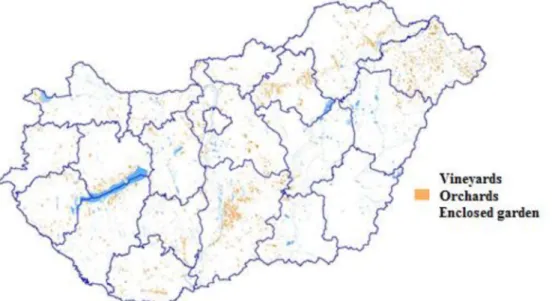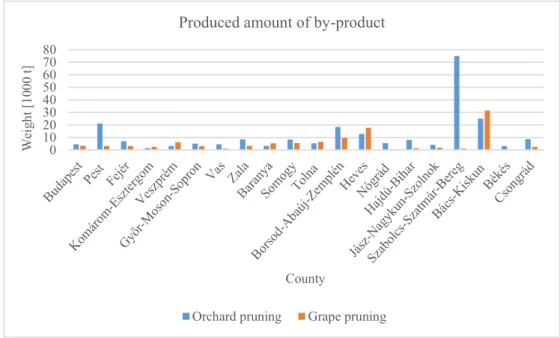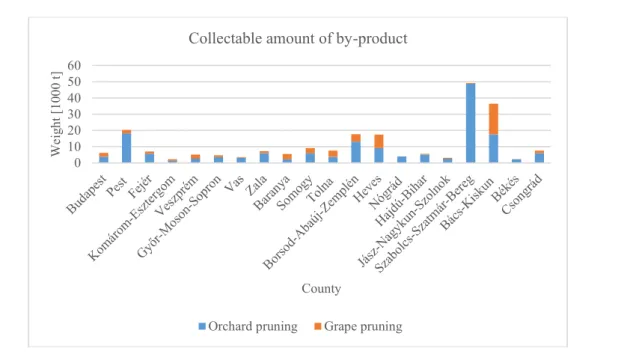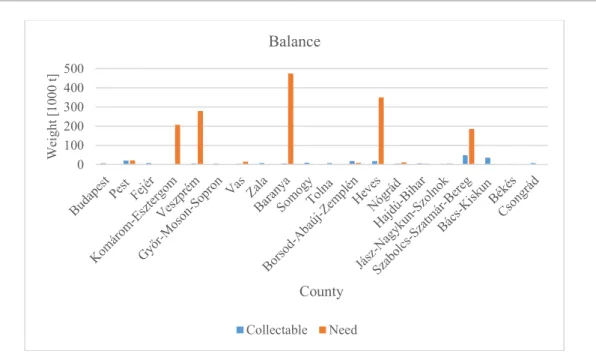Page 211
POSSIBLE ROLE OF AGRICULTURAL WOODY BY-PRODUCTS IN LIGNOCELLULOSE BIOFUEL PRODUCTION IN HUNGARY
Dóra Szalay1*, Zoltán Jákói2, Viktória Papp1
1University of Sopron, Faculty of Forestry, Institute of Forest -and Environmental Techniques, Bajcsy-Zsilinszky u. 4., Sopron 9400, Hungary
2University of Szeged, Faculty of Engineering, Department of Process Engineering, Moszkvai krt. 9., Szeged, 6725, Hungary
Abstract
Agricultural by-products can become the most important feedstock for biofuel production in the future because the expected growth in demand for food crops for food industrial. Thanks to the characteristics of the country, the potential of herbaceous agricultural by-products is outstanding in Hungary.
However, the utilization of woody by-products requires a more advanced technology and its current application is low. The survey results for base materials reveal there are about 165 thousand tons of fruit tree pruning annually. This by-product has a relatively high calorific value, which could provide 2.6 PJ of energy if utilized. About 57 thousand tons of by-products can realistically be collected from vineyards; these by-products could supply nearly 1 PJ of energy content.
Keywords: biomass, agriculture, woody by-products, biofuel, grape pruning, fruit tree pruning, short rotation coppice
1. INTRODUCTION
Using biomass for energy and industrial purposes is becoming an important tool for reducing greenhouse gas emissions in the world. Biomass also plays a significant role in energy supply.
primary energy demand in 2016 was more than 1000 PJ, of which 12.5% was covered by renewable energy sources. Biomass and other municipal biowaste amounted to three-quarters of this renewable energy [1], see Figure 1.
Fig. 1. The share-out of primary energy production from renewables and biowastes in Hungary in 2017 [Data based on KSH, 2018]
Hydro energy
1%
Wind energy 2%
Geothermal energy
4% Solar energy 1%
Biogas 3%
Biofuel 13%
Biomass and biowaste
76%
Page 212
The methodology for statistical calculation has changed due to a new EU regulation (European Commission 431/2014). Based on this new calculation system, the EUROSTAT data reported that renewable energy sources comprised more than 14% of Hungarian energy consumption in the same year, making the 14.65% target Hungary needs to meet by 2020 very close. Current Hungarian biomass energy utilization is happening mainly in thermal and electric power plants and, to a lesser extent, in biogas plants, pellet, briquette, and chipboard production. The amount of renewable biofuel consumption in transport is about 7.4%, most of which is covered by first-generation biofuels [2].
The new legislation is a challenge that encourages biofuel production from agricultural, forest, and industrial by-products to avoid a food conflict. Hungary is an agricultural country and its capability for biomass production is excellent. Agricultural land makes up more than three-quarters of the approximately 6 million hectares of growing area; thus, about 92% of total potential biomass by- products comes from herbecaous by-products [3]. Harvesting, storing, and utilizing technologies for these materials are less sophisticated than those employed with woody by-products. The development of biofuel production technology from high bark content biomass is ongoing; however, not much research has been completed regarding the sustainable base material supply of biofuel plants.
Nevertheless, it remains an important research area because the conversion of lignocellulose biomass to liquid biofuels requires a far more complex technology than food crop-based first generation biofuel production does. Conversion rate and production capacity are also lower, yet the investment cost can be up to ten times higher for advanced biofuel plants. Lignocellulose biofuels can be produced from a wider range of raw materials that do not limit the food supply.
In Hungary, biomass potential estimations are aimed mainly at direct firing, and the available literature data for the entire country varies. Potential estimation at the county level that includes competing users and ecological considerations will help aid in selecting and installing the appropriate technology as well as determining the location of the planned user plants in the future. Minimizing collection and delivery needs are important from energy, ecological, and economic perspectives.
Although the use of thin wood for direct firing is already widespread, the potential in woody agricultural by-products is currently underexploited. Their use for biofuel production is hampered by the high bark content, which is also responsible for high ash and alkaline content [4-5]. Production technology development is already underway for forestry products with similarly high bark contents [6-7]. Woody agricultural by-products can be freely used for energy purposes because there is no demand for them in soil nutrient replenishment or in animal husbandry. The most important argument against returning the prunings to the soil are the various viruses, bacterial goiters, and fungal diseases they can spread. With maximum safety, this process can be used only on healthy plantations in fertile, biologically active soils.
Grapes and orchards produce relatively small amounts of by-products during pruning, and by-product collection is only economically viable on contiguous large-scale plantations. Large differences in by- product amount exists in vineyards, with 1-4 tonnes per year per hectar depending on the grape species [8-9]. Vineyard by-products have a relatively high heating value, making them optimal for firing [10- 11]. The mechanization of the energetic utilisation has been solved; nonetheless, only a few places collect the by-products and most by-products continue to be burned on-site in the vineyard. Only a small part is chopped up and returned to the soil.
Fruit trees generate a smaller annual amount of by-products during thinning, and produce many more branches during renovation prunings, which occur every four to five years. The average amount of by- product is 2 3 t/ha/yr [12]. Similar to grape prunings, the calorific value and ash content of the produced material is relatively high. Collection technology development in Western Europe is ongoing [13-14].
Although it is not an agricultural by-product, short-rotation energy plantations can be productive in unused agricultural areas provided the appropriate tree species are planted. Woody energy plantations have different yields, ranging from 5 to 25 atro t/ha/year depending on the cultivation area, technology, climate, and applied tree species/clones [15-16]. The average yield for poplars grown in Hungary is 10 atro t/ha/year, with a heating value of 18 MJ/kg [17-18].
Page 213 2. MATERIALS AND METHODS
Estimations for potential woody by-products from grape and fruit tree cultivation were based on the 2017 and area by cultivat table of the KSH (Central Statistical Office). Collecting these by- products is only economical on larger contiguous areas; thereby we have only considered farms over 3 ha for potential collection. We used the KSH size categories for grape and fruit plantations for our calculations, which were surveyed during the 2005 and 2007 agricultural censuses.
Woody energy plantation cultivation is only possible in the agriculture sector. Since produced base material quality is similar to the other two examined categories, we also completed a survey based on the data provided by the Forestry Directorate of NÉBIH (National Food Chain Safety Office) in 2019.
The characteristics of the analysed dendromass raw materials are summarized in Table 1.
Amount of by-product [t/ha] Heating value [MJ/kg] Ash content [%]
Grape pruning 1.5 17.5 (15.0*) 2.6
Orchard cutting 2.5 18 (15.5*) 2.8
SRC** 10 18 (15.5*) 1-3
*15-20% moisture content **Short rotation coppice
Table 1. Average characteristics of dendromass raw materials from agricultural areas [8; 10-11; 17-18; 22-27]
3. RESULTS
Biomass availability is an important issue for the biofuel industry. A continual provision of raw materials through long-term contracts is prudent to reduce investment risk. By-products allow for biofuel production without the needs for additional agricultural areas; however, determining the availability of these materials and the need for additional feedstocks is required to meet energy plants needs.
The generally scattered geographical locations where these by-products are generated must be taken into account. Figure 2 illustrates grape and fruit tree plantations locations in Hungary.
Fig. 2. Grape and fruit tree plantations in Hungary based on the Corine Land Cover (CLC) surface map
Page 214
Survey results show a significant amount of pruning from large-scale vineyards and orchards. The annual amount of prunings by county is shown in Figure 3. The by-products generated during fruit tree cultivation is concentrated in Szabolcs-Szatmár-Bereg county. Furthermore, by-product mass is significant in both Bács-Kiskun and Pest counties. Prunings produced during grape cultivation are also significant in Bács-Kiskun and Pest counties.
Fig. 3. Annual amount of prunings from vineyards and from orchards by county
The most important aspect of usability is organizing by-product collection. The larger continuous plantations can be considered primarily for both by-products. Vineyards in Vas and Zala County are individual farms with an average size of 0.1 0.2 hectares, whereas the average size of vineyards are 2 3 hectares in Bács-Kiskun and in Heves counties. The larger farms over 30 hectares are mainly in Southern Transdanubia, Fejér, Komárom, Pest counties, and Budapest. Regional differences in average orchard size are also significant. Cooperatives typically cultivate on smaller farms in the southern regions where the average area is 11 hectares, while ones in Budapest, -Moson-Sopron counties are above 30 hectares. Based on 2017 KSH data, individual farms operate on larger areas in the major fruit-producing counties with the exception of Vas and Borsod-Abaúj-Zemplén counties. Figure 4 contains our calculation results for the annual amount of collectable prunings.
100 2030 4050 6070 80
Weight [1000 t]
County
Produced amount of by-product
Orchard pruning Grape pruning
Page 215
Fig. 4. Amount of annually collectable prunings from vineyards and orchards over 3 ha by county
These by-products have a relatively high calorific value. According to our survey, the amount of collectable fruit tree prunings is about 165 thousand tons annually, which would provide 2.6 PJ of usable energy. In the case of vineyards, 57 thousand tons of prunings can be realistically collected, which equals an energy content of nearly 1 PJ.
Orchards and vineyard by-products are used for energy purposes only in small quantities by a few power plants or heating plants in the country. The Mátra Power Plant uses approximately 10,000 tons of vineyard prunings in Visonta yearly, and a few hundred tons of orchards prunings are fired in the Pannonhalma biomass power plant. Further smaller amounts are used in biomass boilers as those in Homrogd and in Szombathely.
Furthermore, bark-free sawdust is produced during grape vine propagation. Although this material amounts to a small fraction, it is a freely usable material for energy purposes. About 1.5 million grafts are produced annually during large-scale propagation production, which results in 150 m3 (~ 30 t) of sawdust. It may be worth collecting this sawdust in the case of three or four large-scale vine growers operating in the country.
The question of how much free-to-use potential exists after satisfying current needs is an important one for by-products. The biomass base material demand is great. Figure 5 summarises the major biomass power and heating plants by counties. Baranya, Heves, Veszprém, Komárom-Esztergom, Szabolcs- Szatmár-Bereg counties will not have any further free collection potential.
0 10 20 30 40 50 60
Weight [1000 t]
County
Collectable amount of by-product
Orchard pruning Grape pruning
Page 216
Fig. 5. Collectable biomass potential and needs of competing users by county
Despite to the economical 50-km transport distance of wood chips, raw material can also arrive at the large power plants from longer distances. This implies neighboring counties can, in fact, become potential raw material suppliers. If we calculate transport distances of no longer than 100 km, the potential in the western and south-eastern part of the country still exists. Selling the raw material to a large number of biomass power plants in foreign markets exists in the western regions, even for longer transport distances.
Along the south-eastern border of the country, only 2-7 thousand tons of free potential material are available in Hajdú-Bihar, Békés, Csongrád counties. Using these materials locally in smaller heating, pelleting or briquetting plants is recommended. It is currently possible to utilize more than 30,000 tons of woody by-products in Bács-Kiskun County; see Figure 6.
Fig. 6. The free potential of agricultural woody by-products
Further intensive dendromass production from agricultural areas is possible through short rotation energy plantations. Although these raw materials are produced as a main product, the provision of
0 100 200 300 400 500
Weight [1000 t]
County Balance
Collectable Need
Page 217
appropriate tree species selection and careful soil preparation makes it possible to grow these plantations in low-quality agricultural areas.
According 2019 Forestry Director of NÉBIH data, energy plantations in Hungary total 4351 ha, of which about 80% is cultivated with poplar species due to the suitability of the species in the available areas [28]. Willow accounts for 7.4% and black locust accounts for 7% of the total plantation area. With regard to cultivation technology, the majority of plantations are cultivated with coppicing technology.
Estimating the amount of base material from plantations is extremely cumbersome. We can calculate with an average yield of 10 t/ha/year and with a heating value of 18 MJ/kg [18]. The length of the cutting rotation strongly influences the amount of produced dendromass yield. Figure 7 displays the average energy content of harvested energy plantations by county.
Fig. 7. The energy content of biomass from woody energy plantations by county
The most significant amounts of energy from woody energy plantations are in Veszprém, Baranya, and Somogy counties. However, it is worth noting the base material from energy plantations are supplied to power plants first, which renders their potential as fixed. Free potential would occur only through the creation of large-scale plantations.
4. DISCUSSION
According to NÉBIH Forestry Directorate data, the creation of new woody energy plantation has completely ceased in recent years. The reason is the lack of support and the opening of a HUF 5 billion tender for the installation of new industrial woody plantations (135/2017 (VI.9.) Government Decree, Rural Development Program Support for Reforestation In addition to raw material production, this type of plantation also increases the carbon sequestration of agriculture. Subsidy payment requirements exist in industrial woody plantations. These require the sale of more than 50% of the timber production for industrial purposes within a minimum of 20 years. Special attention is focused on the range of ineligible activities, including the establishment of woody and short rotation plantations for energy purposes.
In the case of woody plantations for industrial purposes, large amounts of residues (10%) and bark (15- 17%) are available, both of which can be used for energy production. Wood yield is around 70%.
Energy content [10-3 PJ]
County Woody Energy plantation
Populus x eur. Salix a. Robinia ps.
Page 218
According to literature data, average wood yield at the age of 12 is 27 m3/ha/year [29]. Calculating this data reveals up to 5 t/ha/year of usable biomass can be available for energy purposes. If we do not take into account the bark residue, we can collect 1.0-1.5 t/ha/year of by-product. However, if we use the allowed 49% weights for energetic purposes, an additional 5 tonnes can be achieved on an absolute dry matter. In addition, in the first three years of the cultivation, we can also include the cuttings that are produced during the formation of the 6 to 8 m high clear strain.
A very viable land-use opportunity is the agroforestry cultivation method, which is an intermediate solution offering numerous ecological and environmental advantages [30]. In the case of the applied trees appearing in intermediate cultivation, the carbon sequestration through the deeper roots occurs in deeper layers of the soil compared to the herbaceous plants. These cultivation systems serve as a good tool for increasing carbon sequestration in the agricultural field, but also help to prevent the increasing fire risk of dendromass production, especially in southern European countries [31].
About 38,000 tons of raw materials are needed to operate a pyrolysis plant of size similar to the Empyro plant in Hengelo. The first and most important aspect in user plant selection and instillation is the availability of a high local feedstock. To ensure the critical ash limit value, it is advisable to mix the by- products or chips from the plantations half-and-half with debarked wood before supplying them to the system. This mixing compensates for the reduced pyrolysis oil yield due to the high bark content of the raw materials.
In Bács-Kiskun County, raw material availability would be sufficient to install a pyrolysis plant of a similar size to Hengelo. If the plant is supplied with 50% wood industry by-products and 50% by SRC, then about 1,900 ha of plantation would be needed with the calculation of a yield 10 atro t/ha. However, plantations may even triple the area needed for their cultivation when planted on low-quality agricultural soils. There are more than 300 ha of plantations near the current power plants. Thus, around six settlements would need to cooperate to supply a commercial production plant calculation with optimal yields.
5. CONCLUSIONS
Potential estimation of the amount of woody by-products produced on agricultural land in the country was determined by county. The reported 200 thousand tons of dendromass by-products will most likely be used for electricity generation, in the case of collection. The 35,000 tonnes of free potential in the south-east of the country can be used to produce liquid biofuel or with transport distances of more than 100 km transport distances to existing power plants. SRC raw materials, which can be grown on agricultural land, can supplement orchard and vineyard by-products well. Both cases require a well- organized system. Fruit trees generate a smaller amount of by-products during years with fewer cuttings whereas more by-products occur every four or five years during renovation cuttings. The same holds true for energy plantations, where cutting rotations determine the frequency of harvesting.
ACKNOWLEDGMENTS
The described work was carried out as part of the Sustainable Raw Material Management Thematic Network -3.6.2-16-2017-00010 project in the framework of the Széchenyi 2020 Program. The realization of this project is supported by the European Union, co-financed by the European Social Fund.
Page 219 REFERENCES
1. KSH Central Statistics Office of Hungary 2017, Energy (2006 2017) http://www.ksh.hu/thm/3/indi3_1_2.html
2. Bioenergy Europe Statistical Report 2018 3.
University of Sopron. p. 138.
4. Frankó B; Galbe M; Wallberg O 2015, Influence of bark on fuel ethanol production from steam- Biotechnology for Biofuels 8(1), DOI: 10.1186/s13068-015-0199-x
5. Tröger N; Richter D; Stahl R 2013, Effect of feedstock composition on product yields and energy recovery rates of fast pyrolysis products from different straw types J Anal Appl Pyrol. 100, pp.
158-65.
6. VTT 2019, VTT develops new gasification approach to turn forest biomass into biofuels and biochemical.
https://bioenergyinternational.com/research-development/vtt-develops-new-gasification-approach- to-turn-forest-biomass-into-biofuels-and-biochemicals
7. Neste 2017, Neste and Bioenergy La Tuque to start R&D cooperation on utilizing forest residues in biofuel production https://www.neste.com/neste-and-bioenergy-la-tuque-start-rd-cooperation- utilizing-forest-residues-biofuel-production
8. Hajdú J 2009, Alternatív energiatermelés a gyakorlatban-Technológiák és gyakorlati alkalmazások Karbonpiac 2009Conference proceeding II., p. 170.
9. Gonda C 2014, S hasznosításban
Phd Thesis. University of Debrecen. p 131.
10. Hajdú J 2015, ,
pp. 26-28.
11. Rátonyi T 2013, Biomassza anyagismeret Digitális Tankönyvtár. University of Debrecen.
https://www.tankonyvtar.hu/hu/tartalom/tamop412A/2011-0085_biomassza_anyagismeret/ch03.ht ml
12. Marosvölgyi B 2002 Biomassza-hasznosítás I University book. University of West Hungary, Sopron.
13. Velázquez-Martí B; Fernández-González E; López-Cortés I; Salazar-Hernández DM 2011, Quantification of the residual biomass obtained from pruning of trees in Mediterranean almond groves Renewable Energy 36(2), pp. 621-626.
14. Németh K 2007 A biomassza energetikai hasznosításának gazdasági és környezeti összefüggései I. Terület- és vidékfejlesztési Konferencia Conference proceeding, Kaposvár.
15. Marosvölgyi B 1995, Energetikai célú és a racionális földhasznosítást is szolgáló faültetvények komplex vizsgálata Research report. University of Forestry and Wood Industry. Sopron, pp 28- 31.
16. Marosvölgyi B; Kürtösi A; Tamás R; Tóth G; Petznik P; Körmendi P 1999, Az ERTI által létesített
energetikai faültetvényeken végzett ut ,
Sopron.
17. Kovács G; Heil B; Czupy I; Vágvölgyi A 2013, Fásszárú energia ültetvények termesztés-
technológiája . -13., Tata-Pusztavám.
18. Rénes J 2010, -ellátása
, http://www.e-gepesz.hu/?action=show&id=4742
Page 220 19. Central Statistical Office of Hungary,
20. Central Statistical Office of Hungary, KSH for grape and fruit plantations, which surveyed during the agricultural census in the years of 2005 and 2007
21. Forestry Directorate of NÉBIH (National Food Chain Safety Office) in 2019
22. Német B 2013, hasznosítása Értékálló
aranykorona. pp. 31-32. http://www.physics.ttk.pte.hu/pages/munkatarsak/nemetb/Pub-31-EA- 2013-10-Venyige hasznositas.pdf
23.
Szaktudás Kiadó Ház. pp. 90-97 24. Juhász Gy 2006,
tüzeléstechnikai hasznosítása PhD thesis, University of Debrecen, Debrecen, p. 120.
25. Paulrud S 2015, weden.
http://www.crops4energy.co.uk/wp-content/uploads/2015/11/Willow-as-fuel1.pdf 26.
-Hungary, Sopron, p. 204.
27.
Pecznik P (eds. 55.
28. Borovics A; Csiha I; Benke A 2013, Az energetikai ültetvények fajtaválasztéka, Dendromassza alapú energiaforrások University of West Hungary Publisher, p. 12-15.
29. Nagy I 2016, Csodavárás helyett egy lehetséges megoldás -ültetvény! (1. rész) - . http://erdo-mezo.hu/2016/02/07/csodavaras-helyett-egy-lehetseges-megoldas- jovonk-az-iparifa-ultetveny-1-resz/
30. Jose S (ed.) 2010, Agroforestry for Ecosystem Services and Environmental Benefits Springer Publishing House, ISBN 978-90-481-3322-2.
31. Kumar BM; Nair PKR (eds.) 2011, Carbon Sequestration Potential of Agroforestry System Springer Publishing House, p. 307. ISBN 978-94-007-1629-2.
View publication stats View publication stats
![Fig. 1. The share-out of primary energy production from renewables and biowastes in Hungary in 2017 [Data based on KSH, 2018] Hydro energy1%Wind energy2%Geothermal energy4% Solar energy1%Biogas3% Biofuel13%Biomass and biowaste76%](https://thumb-eu.123doks.com/thumbv2/9dokorg/1288750.103173/1.892.208.682.748.1035/production-renewables-biowastes-hungary-geothermal-biofuel-biomass-biowaste.webp)




